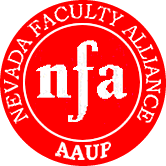Pete Ernaut, a top advisor to Governor Sandoval, gave a lengthy interview to the LV Sun on education, including the comment "Cuts may hurt professors, but they should remember they got generous contracts and benefits for the past 20 years."
But it isn't about being generous; its about investment and market competitiveness.
Higher education faculty compensation and benefits aren't the result of collective bargaining contracts as in K-12 but this point sometimes is lost in the complexity of issues. What has determined any faculty member's compensation isn't (and shouldn't be) the state's generosity; its the state's desire and ability to compete in the national and international market for talented researchers and teachers.
Some data: Even before the economic crisis began in 07-08, Nevada higher ed salaries and compensation were in the middle range of this market. The American Association of Univ Professors annual data for 2009 shows our universities pay in the third quintile (ie 40th to 59th percentile of public universities nationally); the LV Chamber of Commerce in 2008 found our compensation to be only about 80% of the national average for all higher ed workers and only 95% of the national average for instructional faculty. And our benefits amount to only 21% of our total compensation, versus 28% national average. (With total compensation just below the national average, this means our benefits are worth about 75% of national average for higher ed faculty.)
Those statistics were gathered before the first round of 4.6% pay cuts, which the state took on all faculty salaries (including tenured), and before the first round of cuts in health benefits, worth about 7% reduction in total compensation.
The numbers don't lie; we are losing our competitive position in the market. The evidence is that retention rates are declining; more faculty are being recruited to go elsewhere and while in the past we would retain on average 2 of every 3 faculty who got an outside offer, that is down to 1 in 3 last year.
Just for comparison, Idaho (which is mentioned favorably in the interview) is in the top quintile for all its faculty; that is, their compensation is in the 81st to 100th percentile range. And Utah (which he also praises) has invested millions in its U-Stars program, recruiting top researchers and funding them to develop programs that bring direct economic benefit to the state in terms of both short-term direct contribution to the local economy and longer-term benefit of economic diversification.
Thursday, January 20, 2011
Subscribe to:
Post Comments (Atom)






Dr. Brown, according to the Delta Cost Project Nevada spends more per pupil on higher education than Utah. In fact, they ranked us 15th best in the nation. If Nevada has a problem, it isn't with funding higher education it is with effectively using the resources we have.
ReplyDeleteAs I pointed out to you previously UNLV increased the number of administrators faster than the student population growth while also decreasing the number of instructors. That might be part of the problem...
No one is more concerned with the balance between instructional spending and spending on support services than the academic faculty. As we've discussed, I believe your calculation of "administrators" is incorrect, because you include a way array of what are known as "administrative faculty" but are generally professional employees who support research and instruction rather than administrators in the ordinary sense of executive leadership.
ReplyDeleteAs for decreasing the number of instructors, this is why it is worth noting the enhanced contribution to the state -- ie, more work for less pay -- of the current faculty. We understand "shared sacrifice" in a way that it seems Mr. Ernaut does not appreciate.
But the more general point is that we don't spend enough to attract and retain top faculty, and I sense that you agree with me. After all, Utah has committed significant spending to attracting and retaining top researchers in targeted areas.
Finally, as I've suggested in the past, you ought to focus your interest not so much on UNLV but on the state system if you are concerned with administrative costs. That might reveal whether or not we are competitive with other states in terms of the proportion of education spending that we invest in instruction and intellectual capital development.